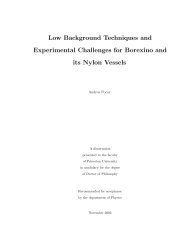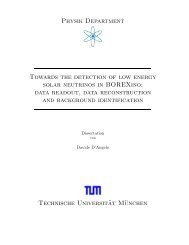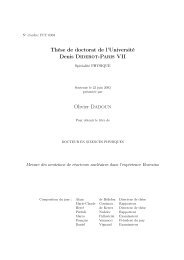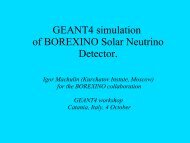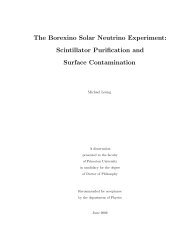Development of a Liquid Scintillator and of Data ... - Borexino - Infn
Development of a Liquid Scintillator and of Data ... - Borexino - Infn
Development of a Liquid Scintillator and of Data ... - Borexino - Infn
Create successful ePaper yourself
Turn your PDF publications into a flip-book with our unique Google optimized e-Paper software.
7 The Source Runs in CTF2<br />
7.4 Analysis <strong>of</strong> the Source Runs<br />
7.4.1 Event Selection<br />
To select the Po alpha decay events, which originated from the Rn source, the following<br />
cuts were applied:<br />
- they are detected by the second electronic group;<br />
- they have a coincidence time delay <strong>of</strong> 10 s-1ms;<br />
- they have a pulse height in the range Ô Õ Ô ( Ô Õ Ô for<br />
source no. 2);<br />
- the preceding group 1 event ( Bi) has a pulse height between 100 <strong>and</strong> 1200 pe (the<br />
lower energy threshold is set to reject accidental coincidences involving C events);<br />
- there is no muon flag on this event or the preceding group 1 event.<br />
With these cuts, the Po alphas <strong>and</strong> the preceding Bi betas can be tagged very efficiently<br />
with negligible background. Their energy spectra are shown in fig. 7.6. Fitting an exponential<br />
to the coincidence time distribution reproduces very well the decay time <strong>of</strong> Po,<br />
Ø × ÐÒ<br />
Ø <br />
¡ ×<br />
while the fit gives ¡ × (see fig. 7.6, lower plot).<br />
Background<br />
The two sources <strong>of</strong> potential background events are Bi- Po events in the bulk scintillator<br />
volume <strong>and</strong> accidental coincidences:<br />
- The background due to Rn present in the scintillator containment vessel can be estimated<br />
to be at about the same level as in the previous runs before the source insertion,<br />
counts per hour. Due to the fact that the scintillator inside the source vial was<br />
quenched <strong>and</strong> the energy <strong>of</strong> the Po alpha peak shifted towards lower energies, the<br />
actual background contribution is even smaller.<br />
- The accidental background can be estimated by applying the energy cuts mentioned<br />
above for the group 1 <strong>and</strong> group 2 events, but taking a coincidence time window shifted<br />
to much greater delay times (7010 - 8000 s). For run 797 this gives an accidental background<br />
rate <strong>of</strong> counts per hour.<br />
Compared to the source activity <strong>of</strong> 200 - 800 counts per hour (for source 1 <strong>and</strong> 2 respectively)<br />
both background contributions are negligible.<br />
104



